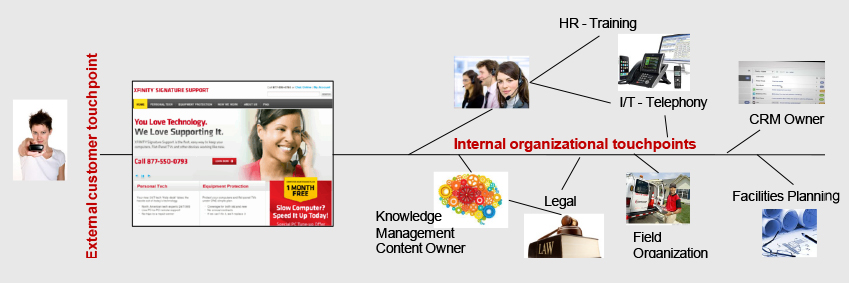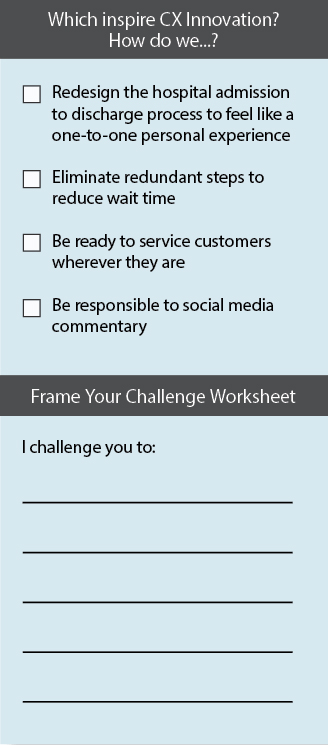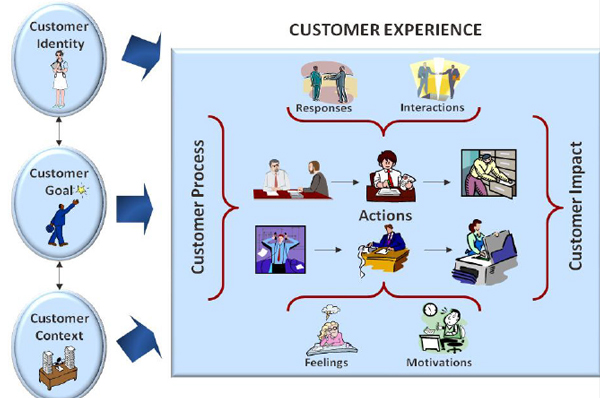A CEO reviews results from a recent customer survey, but implications remain unclear. What is driving the ratings? What, specifically, will improve the customer experience and by how much?
Measures have merits and limitations
Customer satisfaction or loyalty measures are indicators of how well organizations meet customer needs. An overall score can be valuable for tracking progress or to motivate action.
Ratings are not useful, however, when companies view a score itself as the end goal and rely on past performance to shape the future. Chasing a score can anchor management mindset on advancing current processes, rather than reinventing them for breakthrough improvement. Current customer loyalty measurement systems have built-in limitations:
- Living in the past. Scores snap a picture of how customers reacted to services and products as they existed yesterday. But where are customers headed? Things change. Companies wouldn’t use only last year’s Profit and Loss statement to choose new markets. They can’t use loyalty ratings to design for the future.
- Skimming the surface. Surveys such as Net Promoter Score (NPS) provide a reliable tally of customers likely to recommend a product or service to friends, but these customers became promoters and detractors for a reason. Why? Discovering what’s behind the score is essential for identifying a fix. However, many studies don’t ascertain underlying drivers, uncover the most problematic aspects of the customer experience, or prioritize efforts based on what customers value most.
- My score, your score. Benchmarking one region versus another might stimulate desire for improvement in one manager, but it could become a source of consternation for another. Figure 1 is an example of ACSI benchmarking. Competition works if there is a level playing field, but, most of the time, the benchmarked unit isn’t directly comparable. Or, by design, two companies target different segments.
- Unexpected reactions. A simple number can both stir and stall corporate response. While easy to explain and understand, a score can actually deter action: a low number can make people feel unappreciated and powerless, while a high number may draw a “good enough” reaction, lacking urgency for improvement.
Due to these limitations, current customer loyalty measurement systems unintentionally encourage a hold on the status quo, inside-out incremental thinking, and tunnel vision. Too often, companies focus excessively on the score itself, a comparison to some benchmark, or computations behind the score. Cross-tabs are run, statistical significance is checked, and measures beget more measures.
When time analyzing scores exceeds time looking for solutions, then an organization needs to rethink its approach. Companies need to proactively loosen their grip on the status quo. Then, use innovation and integration skills to define and implement the new, more competitive customer experience.
Losing bias towards the status quo
While many companies know their customer loyalty score, few do something with it. Professors Jeff Pfeffer and Robert Sutton, authors of The Knowing Doing Gap, (Jeffrey Pfeffer and Robert Sutton. The Knowing-Doing Gap: How Smart Companies Turn Knowledge into Action. Harvard Business School Press, January 2000) researched reasons that knowledge does not turn into action. A couple of root causes seem to especially apply in the world of customer-driven innovation.
- Measurement: “Measurement can obstruct good judgment,” according to the researchers. Numbers appear certain and show relative ranking and, as such, they can create an over-confidence in knowing what’s good and what’s not.
- Memory or precedent: Simply said, people know too much; it’s natural to rely on what one remembers or knows when thinking about improvements. But, this hinders forward-thinking problem-solving.
Firing up innovation and integration skills
Successful organizations proactively shift from a measurement focus to an innovation process, one that starts with a challenge or a reason to innovate and then—in a creative but disciplined fashion—produces new ideas for conducting business in the future. There are multiple elements to innovation competence, such as fostering a culture that values learning from mistakes, having the right ideation and problem-solving tools, and doing iterative testing and development. Done well, these practices can accelerate action by creating great ideas, designs, and well-tested solutions.
Still, new ideas and a compelling vision are not enough. Organizations must also develop integration competence. Even after ideas are generated, there is often a stalemate: no action takes place. Why? Well, the new process or customer interaction design is a shock to the existing system.
Integration competence means addressing the fact that new ways of doing business can’t simply be appended to existing operations. They need to be integrated— established methods must be carefully connected to the new methods so new ideas survive integration while old methods do not break down. Common behaviors exist among organizations that integrate effectively:
- Early collaboration with stakeholders to predetermine operational touchpoints
- Determination of linkages and dependencies
- Continual management to counter natural gravitational forces back to the old ways.
Integrating Innovation of Internal Touchpoints
 Web chat may be seen as an easy, back-up method for web-based customer service, supplementing an interactive Q&A capability and a deep and indexable knowledge base. However, many customers will activate online chat only after searching for answers themselves. Do customer service representatives servicing the online chat channel use the same language as the online knowledge base? Are they prepared to both answer the question and guide the customer to where the answer was online, to help the customer help themselves next time? Adding web chat is not about technical functionality but customer perspective and cross-channel consistency.
Web chat may be seen as an easy, back-up method for web-based customer service, supplementing an interactive Q&A capability and a deep and indexable knowledge base. However, many customers will activate online chat only after searching for answers themselves. Do customer service representatives servicing the online chat channel use the same language as the online knowledge base? Are they prepared to both answer the question and guide the customer to where the answer was online, to help the customer help themselves next time? Adding web chat is not about technical functionality but customer perspective and cross-channel consistency.
Leading innovation
Leading innovation is not for the faint of heart. When companies turn to PCG with a score in hand, the firm offers an experienced team and proven course of action. PCG helps organizations learn and use an innovation process that delivers customer value. PCG recommends three steps that may not come naturally but can boost innovation success.
1) Framing the Challenge: Driving necessity
 Ron Heiftez authored a seminal book on Adaptive Leadership, (Ronald A. Heifetz, Marty Linsky, and Alexander Grashow. The Practice of Adaptive Leadership: Tools and Tactics for Changing Your Organization and the World. Harvard Business Press, May 2009. Harvard Business School Press, January 2000.) which describes a management approach that molds to a changing environment, creating new methods when a solution is unknown. One of the skills of the adaptive leader is to continuously and conspicuously frame the challenge to succinctly provide context and urgency around an opportunity. This is very powerful in igniting innovation in an organization.
Ron Heiftez authored a seminal book on Adaptive Leadership, (Ronald A. Heifetz, Marty Linsky, and Alexander Grashow. The Practice of Adaptive Leadership: Tools and Tactics for Changing Your Organization and the World. Harvard Business Press, May 2009. Harvard Business School Press, January 2000.) which describes a management approach that molds to a changing environment, creating new methods when a solution is unknown. One of the skills of the adaptive leader is to continuously and conspicuously frame the challenge to succinctly provide context and urgency around an opportunity. This is very powerful in igniting innovation in an organization.
Too often, we see leaders express a challenge as “Increase loyalty by two points,” or “Be in the tenth percentile within the industry.” These are worthwhile goals but not innovative or inspiring. They don’t propel people to step out of their comfort zones. On the other hand, a financial services company striving to “Create no need for a wallet other than for a driver’s license” sets a tone of business-not-as-usual.
Signature Healthcare provided a great example at a conference of customer experience professionals. They described their customer experience strategy for their nursing homes as delivering long-term care as a transformation, not just as a service.
IMPROVEMENT – A company wants to reduce cycle time for approving applications by 20 percent. If the business remains tethered to inside-the-box modifications, it might focus on identifying and addressing single process components, such as eliminating redundancies or removing rework.
INNOVATION – To frame the opportunity as an innovation challenge, the company may instead set a goal to have all customers approve their own applications. The focus then shifts from a limited view on shortening the existing process to the broader vision of rethinking who does what work.
2) Immersive Learning: Walking a day in the life of the customer
To conserve energy, experienced cyclists position themselves to draft behind a strong lead. Organizations with limited resources can also draft behind a powerful force: the voice of the customer. Most companies obtain customer feedback through multiple channels: market research studies, social media, discussion boards, and increasingly through ethnographic research. Listening and watching first-hand are incredibly powerful; companies “get it” in a way that no ranking or score can communicate. It’s also easier to migrate from a customer’s problem to a customer’s solution than from a graph of numbers to a corporate solution. It’s a straighter line.
PCG has several tools which help organizations listen to the voice of the customer.
PCG’s Customer Experience Map shows what customers want and how they go about it. It finds high points and drop points. Tracking the journey from a customer’s start to the customer’s finish provides a rich cross-functional source of customer feedback. As an outside-in perspective, customer experience mapping focuses on what customers need to achieve their goals and then uncovers meaningful changes to better meet those goals. This is the PCG Domain of Customer Experience.

With this kind of mapping and immersive learning, teams are better able to:
- Identify opportunities to tailor services to specific customer segments.
- Create a “challenge” framework that encourages creative thinking, improved communications, and service redesign based on motivations, experiences, and values.
- Promote real understanding of customer reactions which in turn create company responses, which trigger other customer responses.
- See the experience within the context of the customer’s identity, goal, and mental model.
- Highlight fail points, including customer difficulties and excessive costs.
By sorting through the customer journey starting from the customer’s persona or identity as well as their situation and goal, the map uncovers more of the “why” behind the their activities.
3) Prioritization
PCG’s Leverage Analysis provides quantitative evidence of what is most important to fix. It identifies priorities. Even with increased understanding of the customer experience, efforts can stall when companies can’t address all of the opportunities. Determining high-priority areas is not straightforward. It makes sense to revert to solid, quantitative data, particularly if the organization serves diverse customer segments, maintains multiple delivery channels, or offers a complex service. PCG developed Net Impression® Leverage to determine which service aspects have the strongest relationship with overall customer loyalty. (See Figure 4.)
Leverage is a measure of relative improvement potential. By combining satisfaction ratings from a survey with a derived measure of contribution or importance, leverage analysis tells service providers where to concentrate efforts to have the greatest chance of improving metrics. It’s “bang for the buck.” Making improvements to high leverage areas will improve overall customer satisfaction, loyalty, or NPS more so than making improvements to low leverage areas. Leverage scores can then be used to assess the impact of an improvement.
American Airlines was experiencing decreasing levels of customer satisfaction with its check-in process and in-flight service. PCG developed comprehensive customer satisfaction measurement and improvement programs based on its Net Impression® methodology. Local achievements included launching curbside check-in where it was not in use, streamlining boarding policies and procedures, improving passenger handling during off-schedule operations, and cross-training staff to improve ticket counter-gate agent coordination.
4) Proving the Business Case
No matter how a company makes investment decisions, customer experience improvement needs to link to business outcomes. One method in particular provides robust, quantitative customer-based evidence.
PCG offers the Customer Value Model, a tool used to justify investments in new services and products. It provides a forward-looking focus and can help organizations determine the value of future changes. For those with service development or delivery responsibilities, it answers questions such as:
- How will different service delivery strategies impact key customer segments?
- What type of experience improvement is most valued?
- How many people will use the service?
And the CFO may be interested in the answer to questions such as:
- How will this change increase customer value with less business spending and manpower?
- What mix of investments will deliver the best customer experience at the lowest price?
Conjoint-based models by PCG forecast the future and provide a level of assurance that the changes implemented will be valued by the market.
California Water Service Company was experiencing rising customer demand at its office and call centers and sought to examine servicing alternatives for customers to access billing, collection, payment arrangement, and severance transactions while improving service efficiency.
Cal Water’s goals were to:
- Improve service
- Increase efficiencies
- Develop a new channel/service model for eventual company-wide implementation
PCG conducted a conjoint study and created a Customer Value Model that forecasted customer behavior given the new mix. (See Figure 5.) The Model also captured service costs, so management could easily identify initiatives that increased customer value and decreased costs.
Customer-driven innovation returns “much more”
Breakthrough improvements are the result of deep customer understanding folded into a well-managed innovation process. Scores become a success indicator for innovation and integration, rather than a number that sets direction. This shift promotes and sustains a mindset of pushing for change.
With all these efforts, PCG facilitates creativity and provides many years of experience in service businesses. PCG’s innovation process delivers:
- Framing the challenge to inspire innovation
- Customer experience mapping
- Prioritization of customer experience improvements
- Predictive modeling of customer behavior and impact
Working together, PCG and our clients generate customer-driven breakthrough solutions. The kind of innovation that adapts to customer needs while increasing profitability. The path to attaining much more than a score starts and ends with the customer.
